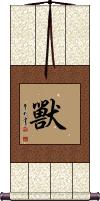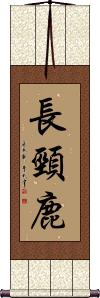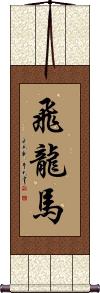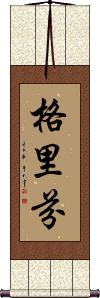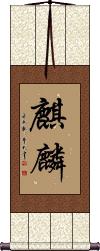Many custom options...
And formats...

Beast in Chinese / Japanese...
Buy a Beast calligraphy wall scroll here!
Personalize your custom “Beast” project by clicking the button next to your favorite “Beast” title below...
Beast / Animal
獸 means beast, animal, brute, beastly, or bestial.
Note: A strange selection for a calligraphy wall scroll.
獸 is a very generic term for a beast, so it can be one hunted for food (such as a deer or boar). It can also mean a great animal or someone who acts like a beast.
Note: In Japanese, this can be the personal name Munetada.
![]() In modern Japan, they use the version of this character shown to the right. If your audience in Japanese, click this special Kanji instead of the button above.
In modern Japan, they use the version of this character shown to the right. If your audience in Japanese, click this special Kanji instead of the button above.
Griffin
グリフィン is the name Griffin in Japanese.
This is used mostly as the name Griffin but can also refer to the mythical beast. It sounds like “Griffin” but does not hold the meaning of the beast known as a Griffin. This is strictly a transliteration of the way Griffin sounds in English but using Japanese sounds to pronounce it.
Note: Because this title is entirely Japanese Katakana, it should be written by a Japanese calligrapher.
Giraffe
Flying Dragon Horse
Griffin
Kirin / Giraffe / Mythical Creature
麒麟 is the title of a mythical beast of Asia.
The animal is thought to be related to the giraffe, and in some ways, it is a giraffe. However, it is often depicted with the horns of a dragon or deer and sometimes with the body like a horse, but many variations exist.
In Japanese, it is pronounced “Kirin” as in “Kirin Ichiban” beer.

Notes:
1. This is sometimes spelled as “kylin.”
2. In Japanese, this is the only Kanji word for giraffe. Therefore in Japan, this word needs context to know whether you are talking about the mythical creature or the long-necked giraffe of Africa.
3. Apparently, this was the first word used for regular giraffes in China (some were brought from Africa to China during the Ming Dynasty - probably around the year 1400). Though the mythical creature may have existed before, the name “qilin” was given to the “new giraffe.” This is because, more than 600 years ago, giraffes somewhat matched the mythical creature's description when Chinese people saw them for the first time. Later, to avoid such an ambiguous title, a three-character word was devised to mean a “giraffe of Africa.” The characters for “qilin” shown here are only for the mythological version in modern Chinese.
4. More information about the qilin / kirin from Wikipedia.
5. This creature is sometimes translated as the “Chinese Unicorn,” although it is generally portrayed with two horns. I think this is done more for the fantasy aspect of the unicorn and because most westerners don't know what a qilin or kirin is (this avoids a long explanation by the translator).
6. In Korean, this can mean kirin or simply giraffe (usually, the mythological creature is what they would think of when seeing these characters alone on a wall scroll).
Not the results for Beast that you were looking for?
Below are some entries from our dictionary that may match your Beast search...
| Characters If shown, 2nd row is Simp. Chinese |
Pronunciation Romanization |
Simple Dictionary Definition |
獸 兽 see styles |
shòu shou4 shou shū |
More info & calligraphy: Beast / AnimalAn animal, a brute. |
蛟龍 蛟龙 see styles |
jiāo lóng jiao1 long2 chiao lung kouryuu / koryu こうりゅう |
More info & calligraphy: Water Dragon / Rain Dragon(1) mizuchi; mythical dragon-like beast, believed to ascend to the heavens through rain; (2) unfulfilled genius; dormant talent; (given name) Kōryū |
主 see styles |
zhǔ zhu3 chu mamoru まもる |
owner; master; host; individual or party concerned; God; Lord; main; to indicate or signify; trump card (in card games) (1) head (of a household, etc.); leader; master; (2) owner; proprietor; proprietress; (3) subject (of a rumour, etc.); doer (of a deed); (4) guardian spirit (e.g. long-resident beast, usu. with mystical powers); long-time resident (or employee, etc.); (5) husband; (pronoun) (6) (familiar language) (See おぬし) you; (given name) Mamoru Chief, lord, master; to control. |
狦 see styles |
shān shan1 shan |
(archaic) vicious dog; beast resembling a wolf |
猊 see styles |
ní ni2 ni gei |
(mythical animal); lion A fabulous beast like a lion, of extraordinary powers. |
獣 see styles |
shòu shou4 shou munetada むねただ |
Japanese variant of 獸|兽 (1) beast; brute; animal; (2) (ケモノ only) (slang) (term used by members of the furry subculture) animal with human characteristics; (personal name) Munetada |
离 see styles |
chī chi1 ch`ih chih |
mythical beast (archaic) |
蛟 see styles |
jiāo jiao1 chiao mitsuchi みつち mizuchi みずち |
a legendary dragon with the ability to control rain and floods; see also 蛟龍|蛟龙[jiao1 long2] mizuchi; mythical dragon-like beast |
豺 see styles |
chái chai2 ch`ai chai sai やまいぬ |
dog-like animal; ravenous beast; dhole (Cuon Alpinus); jackal (1) Japanese wolf (Canis lupus hodophilax, extinct); (2) wild dog jackal |
貎 猊 see styles |
ní ni2 ni |
wild beast; wild horse; lion; trad. form used erroneously for 貌; simplified form used erroneously for 狻 See: 猊 |
人獣 see styles |
jinjuu / jinju じんじゅう |
(1) humans and animals; humans and beasts; (2) (See 人面獣心) beast in human form |
使役 see styles |
shǐ yì shi3 yi4 shih i shieki しえき |
to use (an animal or servant); working (animal); (beast) of burden; causative form of verbs (esp. in grammar of Japanese, Korean etc) (noun, transitive verb) (1) setting (someone) to work; employment; using; (2) {gramm} causative |
力畜 see styles |
lì chù li4 chu4 li ch`u li chu |
draft animal; beast of burden |
半獣 see styles |
hanjuu / hanju はんじゅう |
(See 半人半獣) half-human and half-beast |
卸套 see styles |
xiè tào xie4 tao4 hsieh t`ao hsieh tao |
to loosen a yoke; to remove harness (from beast of burden) |
奇獣 see styles |
kijuu / kiju きじゅう |
unusual beast; strange beast |
妖獣 see styles |
youjuu / yoju ようじゅう |
monster; demon; magical beast |
婆訶 婆诃 see styles |
pó hē po2 he1 p`o ho po ho baka |
vāha; it means bearing, carrying, a beast of burden, but is used in the sense of a large grain-container of twenty bushels 斛; supernatural life, or adbhuta, is compared to a vāha full of hemp seed, from which one seed is withdrawn every century. Also婆訶摩. |
幻獣 see styles |
genjuu / genju げんじゅう |
cryptid (unidentified mysterious creature); mythical beast |
役畜 see styles |
yì chù yi4 chu4 i ch`u i chu ekichiku えきちく |
draft animal; beast of burden beasts of burden |
応竜 see styles |
ouryuu / oryu おうりゅう |
Yinglong; dragon-like beast from Chinese mythology |
応龍 see styles |
ouryuu / oryu おうりゅう |
(out-dated kanji) Yinglong; dragon-like beast from Chinese mythology |
檮杌 梼杌 see styles |
táo wù tao2 wu4 t`ao wu tao wu |
legendary beast |
火車 火车 see styles |
huǒ chē huo3 che1 huo ch`e huo che kasha かしゃ |
train; CL:列[lie4],節|节[jie2],班[ban1],趟[tang4] (1) {Buddh} fiery chariot; (2) kasha (mythical beast said to devour dead bodies); (3) steam locomotive (in China); (4) (abbreviation) (archaism) (See 火車婆) vile old hag The fiery chariot (belonging to the hells); there is also the 火車地獄 hell of the fire-chariot, and the fire-pit with its fiery wheels; the sufferer first freezes, then is tempted into the chariot which bursts into flames and he perishes in the fire pit, a process each sufferer repeats daily 90 koṭīs of times. |
牲口 see styles |
shēng kou sheng1 kou5 sheng k`ou sheng kou |
animals used for their physical strength (mules, oxen etc); beast of burden |
犧牲 牺牲 see styles |
xī shēng xi1 sheng1 hsi sheng gisei |
to sacrifice one's life; to sacrifice (something valued); beast slaughtered as a sacrifice sacrificial animals |
猛獣 see styles |
moujuu / moju もうじゅう |
fierce animal; beast of prey; big game |
猛獸 猛兽 see styles |
měng shòu meng3 shou4 meng shou |
ferocious beast; fierce animal |
猵狙 see styles |
piàn jū pian4 ju1 p`ien chü pien chü |
mythical beast similar to an ape with dog's head |
獙獙 see styles |
bì bì bi4 bi4 pi pi |
mythological beast resembling a fox with wings |
Click here for more Beast results from our dictionary
The following table may be helpful for those studying Chinese or Japanese...
| Title | Characters | Romaji (Romanized Japanese) | Various forms of Romanized Chinese | |
| Beast Animal | 獸 兽 | shishi | shòu / shou4 / shou | |
| Griffin | グリフィン | gurifin | ||
| Giraffe | 長頸鹿 长颈鹿 | zhǎng jǐng lù zhang3 jing3 lu4 zhang jing lu zhangjinglu | chang ching lu changchinglu |
|
| Flying Dragon Horse | 飛龍馬 飞龙马 | hi ryuu me / hiryuume / hi ryu me | fēi lóng mǎ fei1 long2 ma3 fei long ma feilongma | fei lung ma feilungma |
| Griffin | 格里芬 | gé lǐ fēn ge2 li3 fen1 ge li fen gelifen | ko li fen kolifen |
|
| Kirin Giraffe Mythical Creature | 麒麟 | kirin | qí lǐn / qi2 lin3 / qi lin / qilin | ch`i lin / chilin / chi lin |
| In some entries above you will see that characters have different versions above and below a line. In these cases, the characters above the line are Traditional Chinese, while the ones below are Simplified Chinese. | ||||
Successful Chinese Character and Japanese Kanji calligraphy searches within the last few hours...
